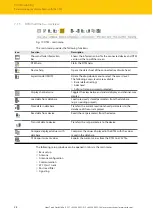
V02.00 | 2020/08
13
4.2
Properties and features
n
Rectangular, height 180 or 300 mm
n
Active front face, UV-resistant
n
Four terminals for passive UHF RFID antennas
n
Four configurable digital channels, which can be configured as PNP inputs and/or
0.5 A outputs
n
2 W (ERP) maximum output power
n
Programmable according to IEC 61131-3 with CODESYS V3
n
CODESYS V3 PLC Runtime
n
CODESYS OPC UA server
n
PROFINET device, EtherNet/IP device or Modbus TCP master/slave
n
Data interface “U” for convenient use of the RFID functionality
n
Close to control integration in PLC systems without the use of a special function block
n
Integrated web server
n
LED indications and diagnostics
4.3
Operating principle
The read/write heads are used for contactless data exchange with tags. For this the controller
sends commands and data via the interface to the read/write head and receives the corres-
ponding response data from the read/write head. The reading of the IDs of all RFID tags in the
read area or the writing of an RFID tag with a specific production date are examples of typical
commands. To communicate with the tag, the data of the read/write head is coded and trans-
ferred via an electromagnetic field, which at the same time supplies the tags with power.
A read/write head contains a transmitter and a receiver, an interface to the interface and a
coupling element (coil and dipole antenna) for communicating with the tag. Electromagnetic
wave propagation is used for the transmission between read/write head and tag on devices for
the UHF range.
IC
Read/write head
Data carrier
UHF: electromagnetic wave
Fig. 3: Operating principle of UHF-RFID
The antenna of the read/write head generates electromagnetic waves. This produces a trans-
mission window as a so-called air interface in which the data exchange with the tag takes place.
The size of the transmission window depends on the combination of read/write heads and
tags, as well as on the relevant environmental conditions.
Each read/write head can communicate with a number of tags. This requires the read/write
head and the tag to operate in the same frequency range. Depending on the power and fre-
quency used, the device ranges vary from a few millimeters up to several meters. The specified
maximum read/write distances only represent typical values under laboratory conditions
without allowing for the effect of materials. The achievable distances may vary due to compon-
ent tolerances, the mounting situation in the application, ambient conditions and the effect of
materials (particularly metal and liquids).
Summary of Contents for TN-UHF AUS-CDS Series
Page 1: ...Your Global Automation Partner Instructions for Use TN UHF CDS UHF Read Write Head ...
Page 2: ...2 Hans Turck GmbH Co KG T 49 208 4952 0 F 49 208 4952 264 more turck com www turck com ...
Page 97: ...V02 00 2020 08 97 Transfer the mapping to the POU Fig 94 Transferring the mapping to the POU ...














































